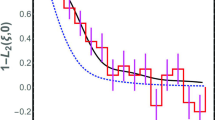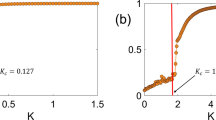Abstract
We consider a model of self-propelled agents with spring-like interactions that depend only on relative positions, and not on relative orientations. We observe that groups of these agents self-organize to achieve collective motion (CM) through a mechanism based on the cascading of self-propulsion energy towards lower elastic modes. By computing the correlation functions of the speed and velocity fluctuations for different group sizes, we show that the corresponding correlation lengths are proportional to the linear size of the group and have no intrinsic length scale. We argue that such scale-free correlations are a natural consequence of the position-based interactions and associated CM dynamics. We hypothesize that this effect, acting in the context of more complex realistic interactions, could be at the origin of the scale-free correlations measured experimentally in flocks of starlings, instead of the previously argued proximity to a critical regime.




Similar content being viewed by others
References
Attanasi, A., Cavagna, A., Del Castello, L., Giardina, I., Grigera, T.S., Jelic, A., Melillo, S., Parisi, L., Pohl, O., Shen, E., Viale, M.: Superfluid transport of information in turning flocks of starlings. arXiv:1303.7097 (2013)
Bak, P.: How Nature Works: The Science of Self-organized Criticality. Copernicus Series. Springer, Berlin (1999)
Ballerini, M., Cabibbo, N., Candelier, R., Cavagna, A., Cisbani, E., Giardina, I., Lecomte, V., Orlandi, A., Parisi, G., Procaccini, A., Viale, M., Zdravkovic, V.: Interaction ruling animal collective behavior depends on topological rather than metric distance: evidence from a field study. Proc Natl Acad Sci 105(4), 1232–1237 (2008)
Bialek, W., Cavagna, A., Giardina, I., Mora, T., Pohl, O., Silvestri, E., Viale, M., Walczak, A.M.: Social interactions dominate speed control in poising natural flocks near criticality. Proc Natl Acad Sci 111(20), 7212–7217 (2014)
Bialek, W., Cavagna, A., Giardina, I., Mora, T., Silvestri, E., Viale, M., Walczak, A.M.: Statistical mechanics for natural flocks of birds. Proc Natl Acad Sci 109(13), 4786–4791 (2012)
Binney, J.J., Dowrick, N.J., Fisher, A.J., Newman, M.E.J.: The Theory of Critical Phenomena: An Introduction to Renormalization Group. Oxford University Press, Oxford (1992)
Brambilla, M., Ferrante, E., Birattari, M., Dorigo, M.: Swarm robotics: a review from the swarm engineering perspective. Swarm Intell. 7, 1–41 (2013)
Breder, C.: Equations descriptive of fish schools and other animal aggregations. Ecology 35(3), 361–370 (1954)
Buhl, J., Sumpter, D., Couzin, I., Hale, J., Despland, E., Miller, E., Simpson, S.: From disorder to order in marching locusts. Science 312(5778), 1402–1406 (2006)
Buhl, J., Sword, G.A., Simpson, S.J.: Using field data to test locust migratory band collective movement models. Interface Focus 2(6), 757–763 (2012)
Cavagna, A., Cimarelli, A., Giardina, I., Parisi, G., Santagati, R., Stefanini, F., Tavarone, R.: From empirical data to inter-individual interactions: unveiling ther rules of collective animal behavior. Math. Models Methods Appl. Sci. 20(1), 1491–1510 (2010)
Cavagna, A., Cimarelli, A., Giardina, I., Parisi, G., Santagati, R., Stefanini, F., Viale, M.: Scale-free correlations in starling flocks. Proc Natl Acad Sci 107(26), 11865–11870 (2010)
Cavagna, A., Giardina, I., Ginelli, F.: Boundary information inflow enhances correlation in flocking. Phys. Rev. Lett. 110, 168107 (2013)
Couzin, I.D., Krause, J., Franks, N.R., Levin, S.A.: Effective leadership and decision-making in animal groups on the move. Nature 433, 513–516 (2005)
Czirók, A., Stanley, H.E., Vicsek, T.: Spontaneously ordered motion of self-propelled particles. J. Phys. A 30(5), 1375 (1997)
Deutsch, A., Theraulaz, G., Vicsek, T.: Collective motion in biological systems. Interface Focus 2, 689 (2012)
Ferrante, E., Turgut, A.E., Dorigo, M., Huepe, C.: Collective motion dynamics of active solids and active crystals. New J. Phys. 15(9), 095011 (2013)
Ferrante, E., Turgut, A.E., Dorigo, M., Huepe, C.: Elasticity-based mechanism for the collective motion of self-propelled particles with springlike interactions: a model system for natural and artificial swarms. Phys. Rev. Lett. 111, 268302 (2013)
Ferrante, E., Turgut, A.E., Huepe, C., Stranieri, A., Pinciroli, C., Dorigo, M.: Self-organized flocking with a mobile robot swarm: a novel motion control method. Adapt. Behav. 20(6), 460–477 (2012)
Fetter, A., Walecka, J.: Theoretical Mechanics of Particles and Continua. Dover Books on Physics Series. Dover, Mineola (2003)
Flierl, G., Grünbaum, D., Levin, S., Olson, D.: From individuals to aggregations: the interplay between behavior and physics. J. Theor. Biol. 196, 397–454 (1999)
Gautrais, J., Ginelli, F., Fournier, R., Blanco, S., Soria, M., Chate, H., Theraulaz, G.: Deciphering interactions in moving animal groups. PLoS Comput. Biol. 8(9), e1002678 (2012)
Gautrais, J., Jost, C., Soria, M., Campo, A., Motsch, S., Fournier, R., Blanco, S., Theraulaz, G.: Analyzing fish movement as a persistent turning walker. J. Math. Biol. 58(3), 429–445 (2009)
Grossman, D., Aranson, I.S., Jacob, E.B.: Emergence of agent swarm migration and vortex formation through inelastic collisions. New J. Phys. 10, 023036 (2008)
Grunbaum, D., Okubo, A.: Modeling social animal aggregation. Frontiers in Theoretical Biology, Lecture notes in Biomathematics, vol. 100, pp. 296–325. Springer-Verlag, Berlin (1994)
Henkes, S., Fily, Y., Marchetti, M.C.: Active jamming: Self-propelled soft particles at high density. Phys. Rev. E 84(4), 040301(R) (2011)
Katz, Y., Tunstrm, K., Ioannou, C.C., Huepe, C., Couzin, I.D.: Inferring the structure and dynamics of interactions in schooling fish. Proc Natl Acad Sci 108(46), 18720–18725 (2011)
Kauffman, S.A.: The Origins of Order: Self-organization and Selection in Evolution. Oxford University Press, Oxford (1993)
Lewin, R.: Complexity: Life at the Edge of Chaos. Nature of Human Society Series. University of Chicago Press, Chicago (1999)
Lukeman, R., Li, Y.X., Edelstein-Keshet, L.: Inferring individual rules from collective behavior. Proc Natl Acad Sci 107(28), 12576–12580 (2010)
Menzel, M.A., Takao, O.: Soft deformable self-propelled particles. Europhys. Lett. 99(5), 58001 (2012)
Mora, T., Bialek, W.: Are biological systems poised at criticality? J. Stat. Phys. 144(2), 268–302 (2011)
Okubo, A.: Dynamical aspects of animal grouping: swarms, schools, flocks, and herds. Adv. Biophys. 22, 1–94 (1986)
Romanczuk, P., Couzin, I.D., Schimansky-Geier, L.: Collective motion due to individual escape and pursuit response. New J. Phys. 102(1), 010602 (2009)
Sumpter, D.J.T.: Collective Animal Behavior. Princeton University Press, Princeton (2010)
Szabó, B., Szöllösi, G.J., Gönci, B., Selmeczi, Z.J.D., Vicsek, T.: Phase transition in the collective migration of tissue cells: experiment and model. Phys. Rev. E 74(6), 061908 (2006)
Toner, J., Tu, Y.: Long-range order in a two-dimensional dynamical XY model: how birds fly together. Phys. Rev. Lett. 75, 4326–4329 (1995)
Toner, J., Tu, Y.: Flocks, herds, and schools: a quantitative theory of flocking. Phys. Rev. E 58, 4828–4858 (1998)
Turgut, A.E., Çelikkanat, H., Gökçe, F., Şahin, E.: Self-organized flocking in mobile robot swarms. Swarm Intell. 2(2), 97–120 (2008)
Vicsek, T., Czirok, A., Ben-Jacob, E., Cohen, I., Shochet, O.: Novel type of phase transition in a system of self-driven particles. Phys. Rev. Lett. 75(6), 1226 (1995)
Vicsek, T., Zafeiris, A.: Collective motion. Phys. Rep. 517(3–4), 71–140 (2012)
Warburton, K., Lazarus, J.: Tendency-distance models of social cohesion in animal groups. J. Theor. Biol. 150(4), 473–488 (1991)
Acknowledgments
The work of CH was supported by the National Science Foundation under Grant No. PHY-0848755. The work of EF, AT and TW was supported by the Research Foundation Flanders (Flemish Community of Belgium) and European Science Foundation (ESF) funded H2Swarm project as well as by the KU Leuven funded BioCo3 IDO Project. The work of AT was supported by the Scientific and Technological Council of Turkey (TUBITAK) 2219 Program. We also acknowledge support by the Max Planck Institute for the Physics of Complex Systems in Dresden, Germany, through the Advanced Study Group “Statistical Physics of Collective Motion”, where part of this work was conducted.
Author information
Authors and Affiliations
Corresponding author
Rights and permissions
About this article
Cite this article
Huepe, C., Ferrante, E., Wenseleers, T. et al. Scale-Free Correlations in Flocking Systems with Position-Based Interactions. J Stat Phys 158, 549–562 (2015). https://doi.org/10.1007/s10955-014-1114-8
Received:
Accepted:
Published:
Issue Date:
DOI: https://doi.org/10.1007/s10955-014-1114-8




